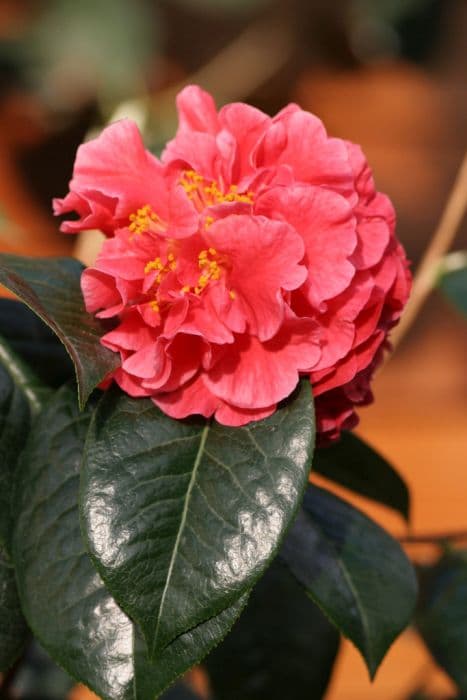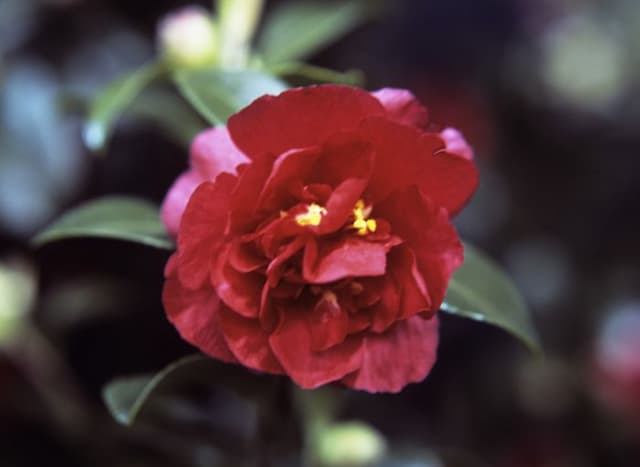Sasanqua Camellia Camellia sasanqua 'Tanya'

ABOUT
The Camellia sasanqua 'Tanya' is a type of camellia known for its striking flowers and elegant foliage. Its beauty lies in the abundance of its blooms and the glossy, dark green leaves that create a perfect backdrop for the flowers. The blooms themselves are typically single or semi-double and are characterized by their soft petals which come in a palette of colors including pinks, reds, and whites. At the center of each flower, a cluster of prominent yellow stamens adds a subtle contrast. The petals may exhibit a ruffled or smooth edge, contributing to the plant's overall grace and charm. The blooms appear to be delicate and almost waxy to the touch. This plant carries its flowers on branches that form a balanced, rounded shape, providing a dense and lush appearance. The leaves are leathery to the touch and have a slightly serrated edge, adding texture to the visual appeal. Overall, 'Tanya' is celebrated for its ornamental qualities and the serene ambiance it can bring to any garden space.
About this plant
 Names
NamesFamily
Theaceae.
Synonyms
Sasanqua Camellia, Christmas Camellia, Winter Camellia.
Common names
Camellia sasanqua 'Tanya'.
 Toxicity
ToxicityTo humans
Sasanqua camellia is not considered toxic to humans. There are no significant reports of poisoning or toxic reactions from ingesting any parts of this plant. Nonetheless, it is always recommended to be cautious and avoid eating ornamental plants as they are not intended for consumption.
To pets
Sasanqua camellia is generally considered non-toxic to pets. It is not known to cause any harmful effects if pets ingest parts of this plant. However, as with any plant material, ingestion can sometimes lead to mild gastrointestinal upset due to the ingestion of non-food items. It is always advisable to monitor your pets around plants and discourage them from eating ornamental plants.
 Characteristics
CharacteristicsLife cycle
Perennials
Foliage type
Evergreen
Color of leaves
Green
Flower color
Pink
Height
4-5 feet (1.2-1.5 meters)
Spread
5-6 feet (1.5-1.8 meters)
Plant type
Shrub
Hardiness zones
7
Native area
Japan
Benefits
 General Benefits
General Benefits- Year-round interest: Camellia sasanqua 'Tanya' offers seasonal blooms in the fall or winter when few other plants are flowering, adding color to the garden during these dreary months.
- Ornamental appeal: With its glossy green leaves and beautiful flowers ranging from white to pink and red, this plant provides high ornamental value to garden landscapes.
- Ease of care: This variety of camellia is relatively low-maintenance, requiring minimal pruning and being tolerant of a variety of soil conditions.
- Privacy screening: Due to its dense growth habit, it can be used as a privacy hedge or screening plant, providing seclusion for your yard or garden.
- Shade tolerance: Camellia sasanqua 'Tanya' can thrive in partial shade, making it a versatile choice for different garden locations.
- Drought tolerance: Once established, it can be quite drought-resistant, needing less water compared to many other garden plants.
- Pest resistance: It is generally resistant to pests and diseases, meaning fewer chemical treatments are necessary.
- Attracts pollinators: The flowers attract bees and other pollinating insects, supporting local ecosystems.
- Longevity: Camellia plants are known to be long-lived, offering many years of enjoyment with proper care.
- Versatility in landscaping: It can be grown as a single specimen, in groups, or even trained as an espalier, offering varied landscaping options.
 Medical Properties
Medical PropertiesThis plant is not used for medical purposes.
 Air-purifying Qualities
Air-purifying QualitiesThis plant is not specifically known for air purifying qualities.
 Other Uses
Other Uses- Sasanqua camellia petals can be added to potpourri mixes for a natural fragrance and a touch of color.
- The leaves of the sasanqua camellia can be used to dye fabrics or paper, giving them a delicate green hue.
- Dried sasanqua camellia blooms can be incorporated into decorative wreaths and floral arrangements for a unique aesthetic.
- The seeds of the sasanqua camellia can be pressed to extract oils that are sometimes used in woodworking to condition and protect tools.
- Camellia wood, being hard and durable, can be used to craft small items such as handles for tools, musical instruments, or intricate carvings.
- In some cultures, sasanqua camellia flowers are used in ceremonial practices, representing purity or seasonal transitions.
- Sasanqua camellia blossoms can be floated in bowls of water as a simple and elegant table centerpiece for events and gatherings.
- Petals from the sasanqua camellia can be used to create natural confetti for weddings or celebrations, which is biodegradable and eco-friendly.
- The dense growth habit of the sasanqua camellia makes it suitable for creating privacy screens or hedges in landscape design.
- Due to its ornamental value, pressed sasanqua camellia flowers can be used in crafting personalized bookmarks or greeting cards.
Interesting Facts
 Feng Shui
Feng ShuiThe Sasanqua Camellia is not used in Feng Shui practice.
 Zodiac Sign Compitability
Zodiac Sign CompitabilityThe Sasanqua Camellia is not used in astrology practice.
 Plant Symbolism
Plant Symbolism- Adoration - Camellia sasanqua is often associated with adoration, as its delicate beauty and long blooming season symbolize a deep, enduring affection for someone.
- Perfection - The perfect form of the camellia flowers represents the ideal or perfection, making it an emblem for something or someone that is unimpeachable in beauty and quality.
- Longevity - The longevity of the plant, with its ability to live for many years, symbolizes a life well-lived, endurance, and stability in relationships or pursuits.
- Gratitude - Given as a gift, Camellia sasanqua can express gratitude or a sense of thankfulness for someone's presence or actions.
- Love - Depending on the color, camellias can convey messages of love. Red camellias speak of romantic love, while pink camellias often represent a longing for someone.
 Water
WaterSasanqua Camellias, like 'Tanya', prefer consistently moist soil that is well-draining, so water when the top inch of soil feels dry to the touch. Typically, this might mean watering once a week, but this can vary depending on climate conditions and soil type. During the growing season in spring and summer, you might need to water more frequently, especially if you're in a hotter, drier climate. Aim for about 1 to 1.5 gallons of water per watering session for a medium-sized shrub, reducing the frequency during the fall and winter when the plant is not actively growing.
 Light
LightSasanqua Camellias, including 'Tanya', thrive in partial shade, with filtered sunlight being ideal. They can tolerate morning sun, but should be shielded from the intense afternoon sunlight to prevent leaf scorch. A spot that receives several hours of morning light and then dappled or indirect light in the afternoon is perfect for these plants.
 Temperature
TemperatureSasanqua Camellias, like 'Tanya', do well in a moderate temperature range and can tolerate minimum winter temperatures down to about 10 degrees Fahrenheit. They prefer an ideal temperature range between 60 to 70 degrees Fahrenheit for optimal growth. Sasanqua Camellias can survive brief periods of colder temperatures but will suffer in prolonged freezes or very hot conditions above 90 degrees Fahrenheit.
 Pruning
PruningPruning Sasanqua Camellias, like 'Tanya', is primarily done to shape the plant or to remove any dead or damaged wood. The best time to prune is after the Camellia finishes blooming but before new growth starts in spring. Pruning can be done annually, but it is not strictly necessary every year unless the plant is becoming too large or needs aesthetic shaping.
 Cleaning
CleaningAs needed
 Soil
SoilSasanqua camellia requires well-draining, acidic soil with a pH range of 5.5 to 6.5. A mix of peat moss, pine bark, and coarse sand or perlite is ideal. Incorporating organic matter can help improve soil structure and provide necessary nutrients.
 Repotting
RepottingSasanqua camellias should generally be repotted every 2-3 years. Younger plants may require more frequent repotting, while established, older plants can go longer. It's best to repot in spring just before new growth starts.
 Humidity & Misting
Humidity & MistingSasanqua camellias prefer moderate to high humidity levels, ideally between 40% and 60%. They thrive in environments that mimic their native humid forest habitats.
 Suitable locations
Suitable locationsIndoor
Provide bright, indirect light and keep soil moist.
Outdoor
Plant in partial shade with well-draining acidic soil.
Hardiness zone
7-9 USDA
 Life cycle
Life cycleThe life of the Camellia sasanqua 'Tanya', commonly known as Sasanqua camellia, begins with the germination of seeds planted in well-draining acidic soil, usually in spring. The seedlings emerge and gradually develop into young plants with glossy evergreen leaves, requiring partial to full sunlight and moderate watering. As the plant matures, it enters a vigorous growth phase where it establishes a strong root system and abundant foliage which can take several years. Once mature, typically between 2 to 5 years, the sasanqua camellia produces profuse, fragrant flowers in the fall or early winter, ranging from whites to deep pinks and reds. After pollination, flowers form seed pods that ripen and eventually release seeds to start the next generation, or the plant can be propagated through cuttings for genetic consistency. Throughout its life, which can span decades with proper care, the plant requires seasonal pruning to maintain shape and encourage healthy growth and flowering.
 Propogation
PropogationPropogation time
Spring-Early Summer
Propogation: The most popular method for propagating the Camellia sasanqua 'Tanya', commonly known as Sasanqua camellia, is through semi-hardwood cuttings. The best time for taking cuttings is usually in late summer after the plant has finished its main growth spurt, typically around July or August. To do so, choose healthy, semi-hardwood stems that are about four to six inches long. Remove the lower leaves and dip the cut end in rooting hormone to encourage root growth. Plant the cuttings in a well-draining potting mix, and keep them moist but not soggy. Cover with a plastic bag or place in a propagation case to maintain high humidity. Roots generally form in one to three months, after which the new plants can be gradually acclimated to less humid conditions before potting them up separately.









